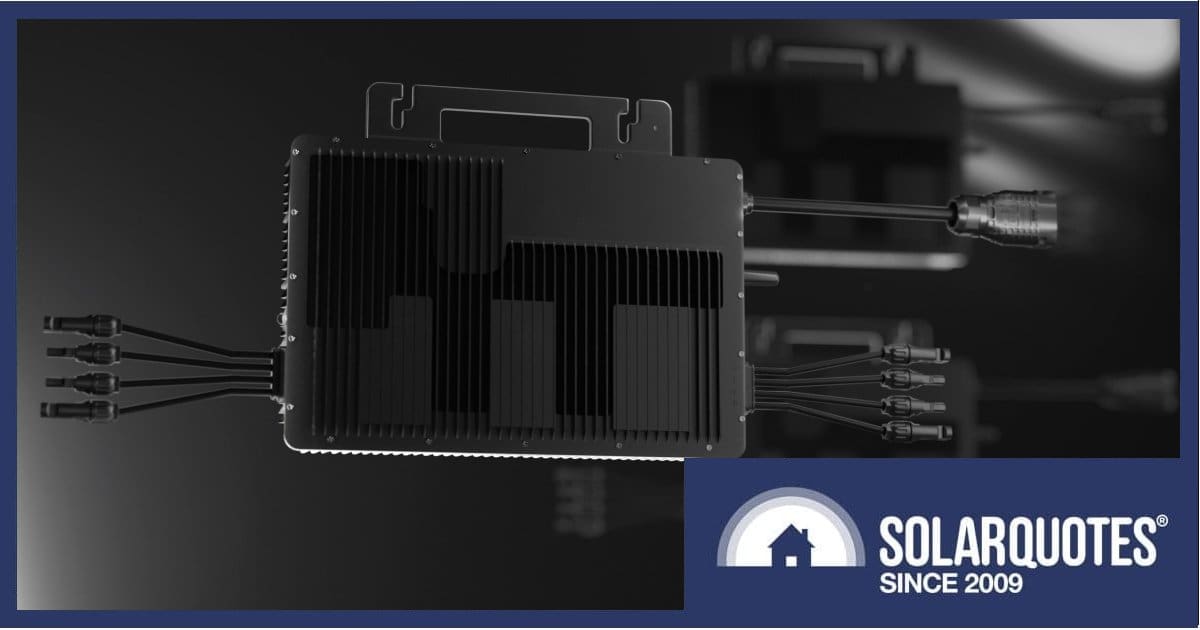
The line between microinverter and string inverter has been blurred with the launch of Hoymiles’ 8-1 MIT series.
When discussing microinverters, the first company that would usually spring to mind is Enphase. But there are other players out there, including Hoymiles – and the firm is eager to steal more of Enphase’s lunch.
Something that sets Hoymiles apart from Enphase is the number of solar panels a device can support. In the case of Enphase, it’s generally one microinverter to one panel. Some Hoymiles devices currently available in Australia support up to four solar panels each. This translates to significant savings on component costs.
One Microinverter, Up To Eight Solar Panels
But “4 in 1” was only the start. Last week, the company announced three new 8-in-1 microinverter models:
- MIT-4000-8T – 4kW rated output, for panels 400W – 650W+.
- MIT-4500-8T – 4.5kW rated output, designed for 560W to 700W+ modules.
- MIT-5000-8T – 5kW rated output, for use with 600W to 750W+ solar panels.
The MIT-4000-8T would be the model best suited to residential installations, but note that all the new models are designed for three-phase, not single-phase power. Most Australian homes have a single-phase connection.
The MIT range’s dimensions are 395mm × 308mm × 60mm and the units weigh in at 8.6 kg. Just as some sort of comparison, a 4kW string inverter weighs 12-16 kilograms.
With no fans and only natural convection cooling, all the electronics packed into such a small box that will spend its life on a rooftop would suggest these microinverters could get particularly hot in operation. While an internal operating temperature wasn’t mentioned, Hoymiles notes an ambient temperature range for the MIT of -40C to +65C. The company states their aluminium microinverter enclosures are designed to dissipate heat quickly and the electrolytic capacitor is located in the coolest part inside the body.
Other features of the MIT include four Maximum Power Point Trackers (MPPTs) for each unit, and the peak power output for each model is 10% higher than rated output. Something I should have asked the company for more detail on is how the device handles eight solar panels with only inputs for four panels visible – 2 into 1 extension leads/connectors are assumed.
As for monitoring capabilities, the company says:
“The Sub-1G wireless solution ensures stable communication with Hoymiles gateway DTU, and enables module-level monitoring and remote O&M on Hoymiles Monitoring Platform S-Miles Cloud.”
In terms of warranty, I haven’t sighted a document specific to the MIT, but this page states:
“… a Hoymiles super microinverter is guaranteed with an industry-leading warranty as high as 25 years.”
However, this page says 12 years. It’s likely the MIT is accompanied by a 12- year product warranty that can be extended to 25 years at an additional cost.
Hoymiles says the MIT series could be a game-changer, something often said by companies regarding any new solar kit they produce.
“It has all the power the industry is looking for, and is extremely cost-efficient,” said Hoymiles CTO and co-founder Dr. Zhao Yi. “We’re very excited – it feels like a huge step forward.”
When Will The MIT Be Available In Australia?
I asked Hoymiles last week when we might see versions of the MIT microinverter for use in Australia. The company said the initial rollout is focused on Europe and North America, and “it may take some time for the listing in Australia”. That’s not a bad thing – they’ll rack up some time working in the field elsewhere, results of which will be useful here.
Are Hoymiles Microinverters Any Good?
Founded in 2012, the first Hoymiles microinverter products were approved for use in Australia in 2022. We’re yet to receive any Hoymiles microinverter reviews from Australian customers. If you have these devices on your rooftop, let us know your thoughts about their performance by leaving a review on that page. We’d be keen to read about your experience, and no doubt other Australians would be too.
- SEO Powered Content & PR Distribution. Get Amplified Today.
- PlatoData.Network Vertical Generative Ai. Empower Yourself. Access Here.
- PlatoAiStream. Web3 Intelligence. Knowledge Amplified. Access Here.
- PlatoESG. Carbon, CleanTech, Energy, Environment, Solar, Waste Management. Access Here.
- PlatoHealth. Biotech and Clinical Trials Intelligence. Access Here.
- Source: https://www.solarquotes.com.au/blog/hoymiles-mit-microinverter-mb2943/
